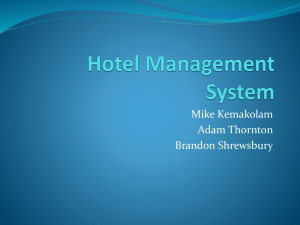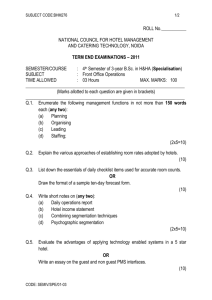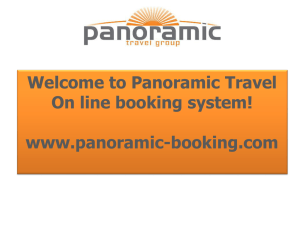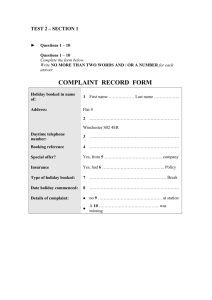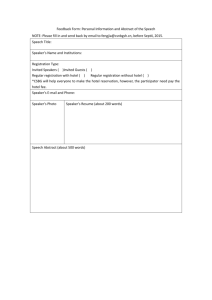Industry overview - InterContinental Hotels Group
advertisement
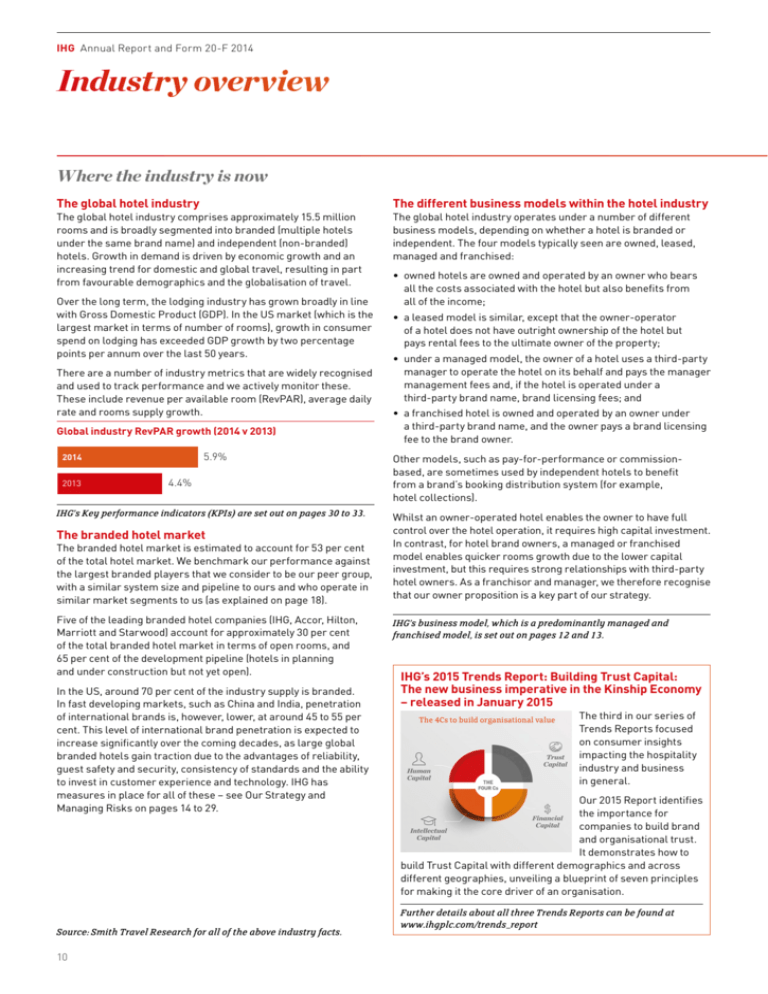
IHG Annual Report and Form 20-F 2014 Industry overview Where the industry is now The global hotel industry The global hotel industry comprises approximately 15.5 million rooms and is broadly segmented into branded (multiple hotels under the same brand name) and independent (non-branded) hotels. Growth in demand is driven by economic growth and an increasing trend for domestic and global travel, resulting in part from favourable demographics and the globalisation of travel. Over the long term, the lodging industry has grown broadly in line with Gross Domestic Product (GDP). In the US market (which is the largest market in terms of number of rooms), growth in consumer spend on lodging has exceeded GDP growth by two percentage points per annum over the last 50 years. There are a number of industry metrics that are widely recognised and used to track performance and we actively monitor these. These include revenue per available room (RevPAR), average daily rate and rooms supply growth. Global industry RevPAR growth (2014 v 2013) 5.9% 2014 2013 4.4% IHG’s Key performance indicators (KPIs) are set out on pages 30 to 33. The branded hotel market The branded hotel market is estimated to account for 53 per cent of the total hotel market. We benchmark our performance against the largest branded players that we consider to be our peer group, with a similar system size and pipeline to ours and who operate in similar market segments to us (as explained on page 18). Five of the leading branded hotel companies (IHG, Accor, Hilton, Marriott and Starwood) account for approximately 30 per cent of the total branded hotel market in terms of open rooms, and 65 per cent of the development pipeline (hotels in planning and under construction but not yet open). In the US, around 70 per cent of the industry supply is branded. In fast developing markets, such as China and India, penetration of international brands is, however, lower, at around 45 to 55 per cent. This level of international brand penetration is expected to increase significantly over the coming decades, as large global branded hotels gain traction due to the advantages of reliability, guest safety and security, consistency of standards and the ability to invest in customer experience and technology. IHG has measures in place for all of these – see Our Strategy and Managing Risks on pages 14 to 29. Source: Smith Travel Research for all of the above industry facts. 10 The different business models within the hotel industry The global hotel industry operates under a number of different business models, depending on whether a hotel is branded or independent. The four models typically seen are owned, leased, managed and franchised: • owned hotels are owned and operated by an owner who bears all the costs associated with the hotel but also benefits from all of the income; • a leased model is similar, except that the owner-operator of a hotel does not have outright ownership of the hotel but pays rental fees to the ultimate owner of the property; • under a managed model, the owner of a hotel uses a third-party manager to operate the hotel on its behalf and pays the manager management fees and, if the hotel is operated under a third-party brand name, brand licensing fees; and • a franchised hotel is owned and operated by an owner under a third-party brand name, and the owner pays a brand licensing fee to the brand owner. Other models, such as pay-for-performance or commissionbased, are sometimes used by independent hotels to benefit from a brand’s booking distribution system (for example, hotel collections). Whilst an owner-operated hotel enables the owner to have full control over the hotel operation, it requires high capital investment. In contrast, for hotel brand owners, a managed or franchised model enables quicker rooms growth due to the lower capital investment, but this requires strong relationships with third-party hotel owners. As a franchisor and manager, we therefore recognise that our owner proposition is a key part of our strategy. IHG’s business model, which is a predominantly managed and franchised model, is set out on pages 12 and 13. IHG’s 2015 Trends Report: Building Trust Capital: The new business imperative in the Kinship Economy – released in January 2015 The third in our series of Trends Reports focused on consumer insights impacting the hospitality industry and business in general. Our 2015 Report identifies the importance for companies to build brand and organisational trust. It demonstrates how to build Trust Capital with different demographics and across different geographies, unveiling a blueprint of seven principles for making it the core driver of an organisation. Further details about all three Trends Reports can be found at www.ihgplc.com/trends_report Where the industry is heading Short-term drivers and global trends Long-term drivers and global trends Technology Technology is playing an increasingly important role in both shaping the travel industry and in guests’ appreciation of their entire travel experience. The internet, increasingly accessed through mobile devices, has established itself as the preferred method to research, plan and book travel. In emerging markets, consumers are bypassing desktop PCs and going straight to mobile – there are twice as many smartphone users in China than internet users in the US. In the long term, growth in the hotel industry is driven by a number of trends: Economic The travel and hotel industries have benefited substantially from long-term macroeconomic trends. Global GDP growth in the last 10 years of approximately 3.6 per cent per annum has contributed to increasing disposable income and a greater number of middle-class households, particularly in emerging markets such as Greater China, with a greater propensity to travel. Improvements in physical infrastructure, particularly in emerging markets, have allowed hotels to meet the needs of guests more effectively and to open up new destinations for travel. Our growth strategy focuses on 10 priority markets comprising both developed and emerging ones. Increasingly, travellers are concerned about the sustainability of hotels and their impact on the environment and local communities. We are committed to responsible business practices from environmental sustainability to supporting our local communities. Competitors These long-term drivers and global trends are changing the competitive landscape within the travel industry. Competitors are no longer simply branded or independent hotels, but also include companies offering alternative lodging solutions and search options, providing inspiration for travel ideas and aggregating a range of travel solutions. The consumer peer-to-peer rental market, which is largely unbranded, has also opened up a large supply of travel accommodation. However, many of these businesses are not subject to regulations such as fire and life safety, food safety and local industry regulations, which apply to traditional hotel operators. For booking and distribution, hotel companies also compete with the increasingly sizeable travel intermediaries. Our channel management strategic priority considers both direct and indirect booking and distribution channels. What is IHG doing in light of these trends? See Our Strategy on pages 14 to 33 11 ADDITIONAL INFORMATION Social Other trends also provide new opportunities for increased travel. Growing competition and capacity amongst airlines, lower air fares and more relaxed travel restrictions in many regions have made international travel a viable option for an increasing number of people. Worldwide, international tourist travel is expected to increase by 3.3 per cent a year from 2010 to 2030 reaching 1.8 billion by 2030, according to the UNWTO. We focus on delivering across the entirety of the ‘Guest Journey’ and invest in developing strong technology platforms. PARENT COMPANY FINANCIAL STATEMENTS Having a portfolio of distinct and complementary brands enables IHG to meet a range of guests’ needs and occasions at differing price points. The ‘Internet of Things’ is an emerging trend that offers enormous potential. 75 billion devices are forecast to be internet-enabled by 2020 offering the potential to transform the in-hotel guest experience. GROUP FINANCIAL STATEMENTS Demographic Traveller demographics are continuously evolving. Many travellers travel for a variety of reasons and no longer for a singular purpose, such as only business or leisure. Across the globe, the types of traveller can range from single people to multi-generation families. The younger workforce is driving more diverse and informal working patterns, with an expectation that hotels can cater for flexible working arrangements. A growing ageing population with the desire, and means, to travel is also expected to significantly increase travel flows and lead to an overall increase in demand for travel services. The development of social networking has changed the way in which people think about travel, with the sharing of experiences, reviews and recommendations influencing research and decision-making. Travellers can make more informed decisions, and book their travel options with greater control and immediacy, leading to an increase in travel to a variety of destinations. GOVERNANCE In developed markets, recent industry revenue growth has been driven largely by an increase in the room rate as occupancy levels have returned to previous peak levels, but the growth in supply of rooms has been below the long-term average. In emerging markets, growth has been a result of both an increase in room rate and the supply of rooms. The industry is also impacted in the short term by local market economic or political factors. STRATEGIC REPORT Short-term industry trends are shaped by differing economic, political or physical factors impacting local geographical markets. Since the economic crisis of 2008/09, GDP growth has returned to key economies, leading to an increase in disposable income and an increase in demand for hotel rooms. Typically, the industry would meet this demand through an increase in the supply of rooms.
